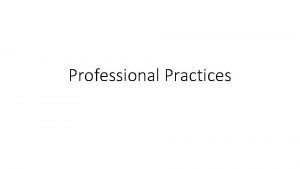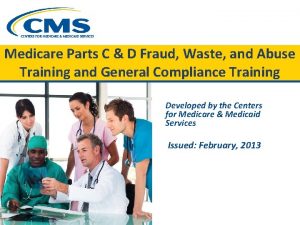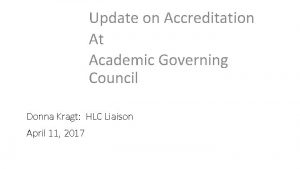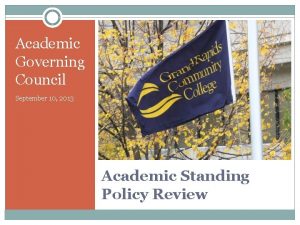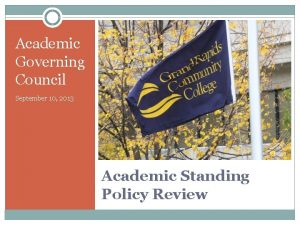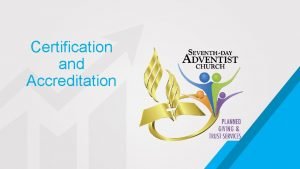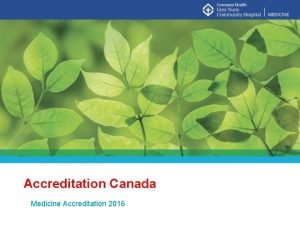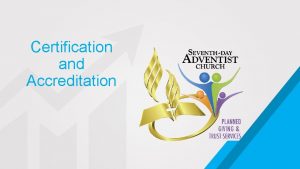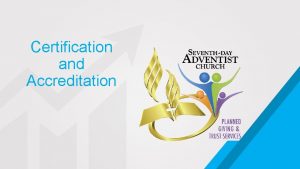Update on Accreditation At Academic Governing Council Donna










- Slides: 10

Update on Accreditation At Academic Governing Council Donna Kragt: HLC Liaison April 11, 2017

GRCC has been continuously accredited by the Higher Learning Commission since 1917 • First accredited: January 1, 1917 • Most recent action: Location approvals for Wyoming Middle College and Cedar Springs Institutional Status and Requirements Report

• A system of Peer Review • 4 major requirements 1. Accreditation Criteria (2014) * Mission * Integrity: Ethical and Responsible Conduct * Teaching and Learning : Quality Resources, and Support * Teaching and Learning: Evaluation and Improvement * Resources, Planning and Institutional Effectiveness

2. Assumed Practices (2015) * 40 specific requirements Examples: “The college shall have an ethics policy for faculty and staff” “The college has clear guidelines for receiving student complaints” “Instructors have the authority for the assignment of grades. ” 3. 14 Obligations of Affiliation (mostly outlining what we will pay for)

HLC is required by the U. S. Department of Education to assure that all of its affiliated institutions are complying with the expectations of specific federal regulations. * Assignment of credits, program length and tuition) * Institutional records of student complaints * Transfer policies * Verification of student identity * Title IV monitoring (federal financial aid) * Transparency of information * Advertising and recruitment materials * Student outcome data (retention and completion rates) * Standing with State and other accrediting agencies * Public opportunity to comment * Competency based programs

Three HLC Options: * Standard Pathway * Open Pathway * AQIP Pathway

AQIP Pathway * GRCC was an inaugural member of AQIP in 2000 * Six categories within which the Accreditation Criteria are imbedded: 1. Helping Students Learn 2. Meeting Student and Other Key Stakeholder Needs 3. Valuing Employees 4. Planning and Leading 5. Knowledge Management and Resource Stewardshi 6. Quality Focus

AQIP Action Projects - Integrated into our Strategic Plan Monitored by the Deans Council First Scholars SARS Early Alert and Scheduling System Guided Pathways Initiative Zero Based Budgeting Initiative

GRCC Timeline Year 2015 -16 2016 -17 2017 -18 Institutional Activities Prep work for Systems Portfolio – Assign category leads, determine data required Prep work for Systems Portfolio – Data collection/initial draft prepared Location Site visit: Wyoming Middle College Submit Systems Portfolio (November, 2017) 2018 -19 2019 -20 2020 -21 2021 -22 Respond to Systems Appraisal 2022 -23 Quality Checkup Visit Comprehensive Quality Review with final recommendation for reaccreditation Attend Strategy Forum (or next year) Attend Strategy Forum (or previous year) Submit Systems Portfolio and Federal Compliance Filing

New Opportunity • HLC maintains a Peer Corps of approximately 1, 600 faculty and administrators from institutions within the 19 -state North Central region. They are responsible for assuring that an institution is complying with the accreditation criteria as well as for helping an institution advance within the context of its own mission. Peer Reviewer Diversity Initiative of 2015 GOAL: 20% of Peer Reviewers from minority groups
 Composition of school governing council
Composition of school governing council Governing body of insurance council
Governing body of insurance council What is an alternative of log based recovery
What is an alternative of log based recovery Nceac curriculum
Nceac curriculum British accreditation council
British accreditation council Governing system
Governing system Ethical principles governing informed consent process
Ethical principles governing informed consent process Ruffles and flourishes protocol
Ruffles and flourishes protocol Downstream entity examples
Downstream entity examples Governing equation heat transfer
Governing equation heat transfer Bypass governing of steam turbine
Bypass governing of steam turbine



